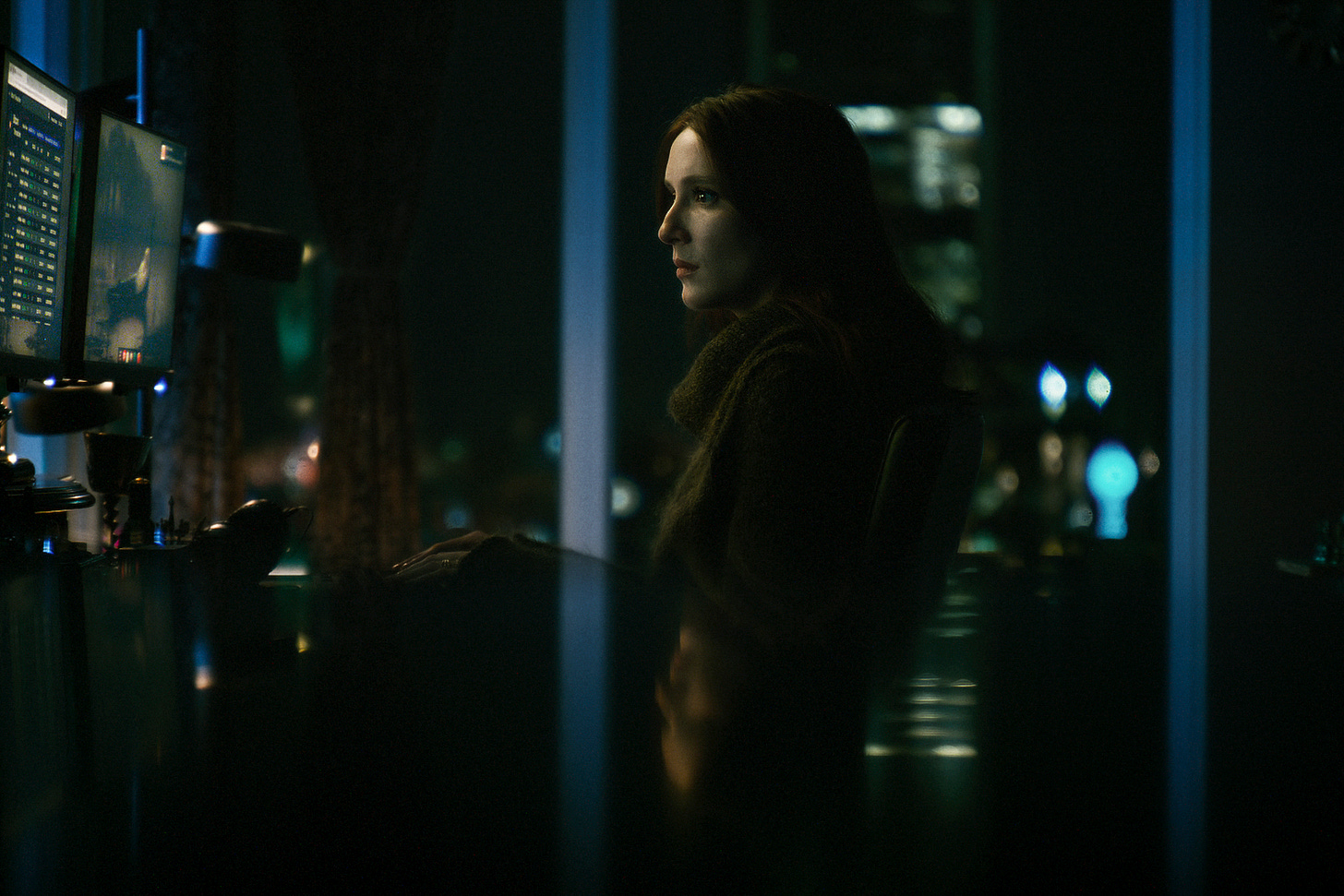The Review: 'Red Rooms' Wants to Make You Sick
Canadian director Pascal Plante's new film, in theaters now, sits at the edge of the digital Rubicon. It's one of the most intense, disturbing, and unforgettable films of the year.
Welcome back to Top Shelf, Low Brow. This is The Review, a regular edition that looks closer at movies, music, and television. This time, it’s the riveting techno thriller Red Rooms, a twisted procedural that questions our relationship to digital violence, and what truth and compassion look like in a world ruled by impulse.
Comfort movies, those old familiars that we turn to when we just want to watch something that makes us feel peace inside ourselves, have always struck me as fascinating. They’re steadfast and reliable, pleasantly cushy because they keep us level instead of moving our internal needle. But what about anti-comfort movies? Films that push, pull, and move us so deeply that they bore into our psyche and affect our very nature. They’re disquieting, and that’s what makes them so deceptive. Our natural response to being distressed by a film’s story is repulsion. “That was so fucked up,” we say when we leave the theater or turn the television off, tossing out verbal attempts to distance ourselves from the horrors we just witnessed onscreen.
But there’s something important in that core feeling, a moral compass that reminds us that our beliefs don’t align with whatever wacko shit went down over the last two hours. Anti-comfort movies are designed to challenge us, to put us firmly on one side of an ethical fence. Provocation elicits fear, compassion, and an examination of our own virtue, and you won’t find a film more provocative this year than Red Rooms.
Canadian writer-director Pascal Plante’s latest feature, in theaters now, fearlessly plunges into the darkest depths of the contemporary human psyche and turns them inside out, naked and wet, so his audience may shudder in the presence of his mirror. What begins as a court procedural about a successful commercial model sitting in on a high-profile trial shifts and regulates itself into something else entirely, before performing this magic trick again. Those subtle narrative switches turn Red Rooms into a labyrinthian descent through the nine circles of Hell, yet remarkably never feel like a drastic change in tone. While Plante’s tale of obsession, justice, and digital neuroses occasionally feels a bit too monochromatic in its constant dourness, that austerity is what makes it so affecting. Red Rooms is not just challenging, it’s consuming.
Plante chooses not to disguise his intentions, and instead, inserts his audience directly into the murky overlap between good and evil. The film opens with beautifully framed planning shots that follow the expressionless Kelly-Anne (Juliette Gariépy) from her secluded spot in an alley of metropolitan Montreal to the belly of the city’s courthouse. She doesn’t want to miss her chance to witness history, and sleeping nearby will guarantee her an exclusive front-row seat to the controversial trial of Ludovic Chevalier (Maxwell McCabe-Lokos). Chevalier is accused of murdering three teenage girls and broadcasting their demise for paying customers on the dark web via Tor, a real-life, open-source network.
The opening credits frame Kelly-Anne against the lapis lazuli hues of the early morning hours, behind the blood-red text of the credits. It’s an omen of what’s to come for the unsuspecting viewer: In case you didn’t know what you’re getting into, the contrast between blue’s purity and crimson rage provides a silent warning to get out for those who can’t stomach what follows. Although Red Rooms dissects our increasingly desensitized relationship with online video and wanton violence, it blessedly never goes so far as to show us any pieces of this evidence. Plante quickly reminds us, however, that what’s unseen can be just as unnerving as what we can observe—if not more. Audio and explanation go a long way in his film, and in those hazier concepts, our minds run wild.
This is where I am thankful that this is my newsletter and I am allowed to deviate for a moment to personally caution you: Watching Red Rooms on an edible is ill-advised. My first go at the movie (before I knew I’d review it, please don’t project sanctimonious movie-watching techniques onto the version of me that didn’t realize what he was getting into), I had to turn it off after a half-hour. I was wholly unprepared for the violent intensity of this experience—and that was just from a barrister’s explanation of the case at hand.
Plante’s dialogue is graphic, sure; it has to be to convey the wickedness of Chevalier’s alleged crimes. But it’s the setting where we first learn details of the case, previously undisclosed to the public, along with Kelly-Anne that really twists the stomach. Fluorescent lights wash out the grey courtroom walls. An accused serial killer sits chained in a glass box. The victims’ parents hush their sobs. It’s sickly mesmerizing, and Plante refuses to let the viewer escape, holding his takes for minutes at a time to keep us spellbound no matter how disturbed we may be; the director as a hypnotist, and this 20-minute opening sequence is the induction into his trance.
Eventually, the human response to acclimate the mind kicks in, and the chaos turns monotone, a low drone like the overhead lights that bleach the courtroom. We remind ourselves this is just a movie, and still, we don’t understand Kelly-Anne’s place in any of it. Or, at least we don’t until she meets Clementine (Laurie Babin), a fellow trial spectator who is far more visibly passionate than Kelly-Anne is. Clementine is obsessed with the case, prattling on to the reporters waiting in the wings about her support for Chevalier, who she believes is wrongly accused. Clementine argues that the video of the third murder, which has gone undiscovered, will prove his innocence. You can’t see the murderer’s eyes clearly enough in the videos, she argues, despite never having seen any of the evidence herself. Clementine parrots the narrative of the fanatic edgelords and true crime obsessives that lurk in online forums, too deep into the muck of conspiracy to realize she is merely a cipher for these faceless figures who get off on molding impressionable minds.
As the trial continues, Kelly-Anne and Clementine become friendly, trading commentary about the proceedings. While Kelly-Anne doesn’t refuse Clementine’s constant anecdotes about circumstantial evidence and corrupt media, she doesn’t refute them either. But she’s always listening. Knowing how people operate is Kelly-Anne’s greatest asset, a weapon she can use to manipulate the world at her will. She affords her cold, stark high-rise apartment—complete with a jailbroken A.I. assistant—via online gambling, where she can rake in large sums quickly by weighing risk with human habit. Her modeling career allows her the freedom and access that come with impossible beauty, and a mask that hides her nebulous intentions. Anyone so exquisite couldn’t possibly have a nefarious ulterior motive, right? As if Jeffrey Epstein and Ghislaine Maxwell didn’t keep the names of the gorgeous and powerful in their black books.
Trying to decipher Kelly-Anne’s mind might have been vexing had Plante not concocted a digital thriller with such massive weight to it that just trying to stop it from sublimating you on the floor keeps you busy enough. Before we know anything deeper about Kelly-Anne, we’re asked to first navigate the maze of how we interact with violence and demoralized iniquity online. Gariépy’s stony appearance doesn’t give way to any hints too early; she is blunt and, at times, rather brusque, an imposing figure who lets the clean lines of her outfits and perfect posture communicate her composure. Gariépy’s hardened chill is masterful considering the subject matter, and never once does she allow her performance to slip. As her dubious opposite, Clementine, Babin is equally impressive. She chatters at the pace of a webpage scroll, flicking past one hot-button topic of discussion to another before she’s even finished her thought about the first. Two women, both stuck on something they can’t move past until proof paints a clear picture.
Like the film it most closely resembles, Olivier Assayas’ brilliant 2002 techno thriller Demonlover, Red Rooms slowly curls and constricts. When you’re focused on making it out of the dark forest before you, it’s easy not to notice this serpent’s grip tightening around your chest, until the film’s harrowing final act ramps up the tension, leaving the viewer asphyxiated, pawing at the dead air around them for help. Kelly-Anne’s actions in the film’s last half-hour reduce its audience to the base of human immorality, as we come face-to-face with the truth at the same moment the characters do. But the choices that prompt these revelations are the most shocking. Plante spends the entirety of the film prodding viewers to question, several times, “Is he going there, can he go there?” Plante’s answer to these quandaries burns like a branding. It’s unpleasant and unforgettable, but a necessary signifier that can pull us back from the edge of the digital Rubicon.
It is ultimately in our nature to be curious about what unsettles us. As much as we can posture and tout our stance on the moral high ground, none of us are impervious to the sickly allure of evil and rage. It’s why films like Red Rooms exist, to function as a map that leads us into the darkness and then back out again, changed by what we encounter in the middle. The journey is unpleasant—nauseating as the roads twist and turn. But coming out on the other side is invigorating. We’ve been witness to parts of the world and of ourselves we knew were always there, but never ventured into before. Observing these rarely-seen sights is briefly intoxicating, but it’s how we respond to the whole agonizing experience that tells us who we are and what we’re made of.










